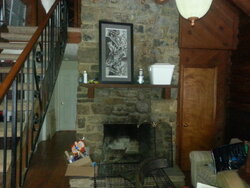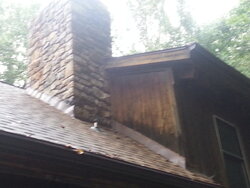Hello and welcome to what I believe is part 4 of the heating conundrum at my house. Some of you may recall from my other threads I had some water entering the house and no small amount of confusion about putting an insert in vs running a liner to the basement with the smoke dragon in it. The recap of current information is as follows. I have a 3 story 3 flue cinderblock chimney with rubble veneer that sits on my foundation and penetrates my roof(s). The flue I'm going to hook up a Heartstone Clydesdale with 6" insulated flex liner(flex king pro) to is a 23' run in a 10"x14" terracotta flue that travels out from the middle floor firebox at a 45 degree angle for ~3' then runs straight up. Top dimensions of the chimney crown are 56"x40" no drip edge. I'm planning on using roxul and durock to insulate my firebox at a minimum on the smoke shelf/block off plate and on the side closer to the exterior wall, due to the reasoning that my chimney is a ton of rock to heat that I'd rather keep in the rooms. The side closer to the upstairs and hall way bedrooms I might just use durcock. I have some high temp 2200 dF paint I'm going to shoot the roxul with to seal in the fibers, also with the help of mellow's thread and the wiki article I think I can handle the block off plate fabrication no problem.


Current questions:
10"x14" shouldn't have any problem with 6" insulated liner even with the bend in there?
High temp silicone was suggested as part of the insert kit and was suggested to be used where the adapter goes into the back of the insert help seal up the air gaps from the crimped edge. "High temp silicone" is only rated at 500 dF; wouldn't that be exceeded after the break in burns are done? If so, its it just a shove it in and forget it or is some form of securing recommended?
Got an IR gun on the way to monitor stove temps, how in the heck would I get flue temps with this set up? 18" from the stove would be me drilling a hole through 3" of stone and then penetrating the liner with a "stabby" probe?
The water entering the house seems to have changed its behavior. Last spring/winter it was running out of the stone where the picture is on the mantle, this fall with all the rain we had the last month it was running down inside the of the flue, dripping off the metal part of the smoke shelf. I'm going to get a piece of 304SS sheetmetal to extend 2" beyond the crown on all 4 sides to help shed water, with my kit I got the 13"x18" cap to further discourage water running down the flue/chimney where the terracotta is "cemented in" any other ideas on this?


Current questions:
10"x14" shouldn't have any problem with 6" insulated liner even with the bend in there?
High temp silicone was suggested as part of the insert kit and was suggested to be used where the adapter goes into the back of the insert help seal up the air gaps from the crimped edge. "High temp silicone" is only rated at 500 dF; wouldn't that be exceeded after the break in burns are done? If so, its it just a shove it in and forget it or is some form of securing recommended?
Got an IR gun on the way to monitor stove temps, how in the heck would I get flue temps with this set up? 18" from the stove would be me drilling a hole through 3" of stone and then penetrating the liner with a "stabby" probe?
The water entering the house seems to have changed its behavior. Last spring/winter it was running out of the stone where the picture is on the mantle, this fall with all the rain we had the last month it was running down inside the of the flue, dripping off the metal part of the smoke shelf. I'm going to get a piece of 304SS sheetmetal to extend 2" beyond the crown on all 4 sides to help shed water, with my kit I got the 13"x18" cap to further discourage water running down the flue/chimney where the terracotta is "cemented in" any other ideas on this?

